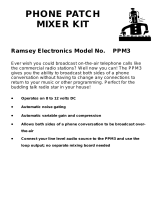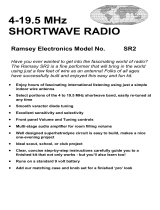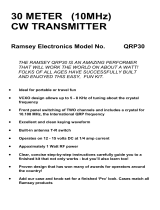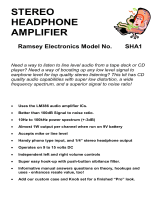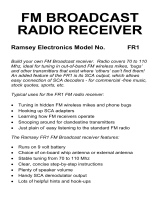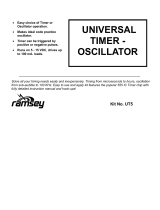Page is loading ...

FM100B • 1
User Manual for Ramsey Model FM100BWT
Here’s the ultimate radio transmitter for any application where a
small, low power transmitter is required! This all-in-one stereo
transmitter has all the features you will ever need for
transmitting a school radio station, around your yard, or even
around the block.
• 2 Line inputs and one mic input-plus a built in mixer!
• Line output for monitoring your broadcast!
• PLL Crystal controlled for rock solid frequency
• Left and right channel peak hold indicators and large LED frequency
display
• Built in power supply, just plug it in! Now operates from 85-264VAC (47 - 63
Hz) without jumpers!
• 1W configuration for operation outside the US!
• Auto AGC microphone muting function for cool talk-overs
• Rugged steel enclosure for years of service
POWER
AUDIO
LEVEL
(L) (R)
PROFESSIONAL
FM STEREO
TRANSMITTER
Model FM100B
SELF
TEST
SETUP
FREQ
UP FREQ
DOWN MIC AUTO
AGC
LINE 1 LINE 2 MIC
MIC
INPUT
MIC ON
FREQ LOCK
-18
-15
-12
-9
-6
-3
0
+3
+6
+9
-18
-15
-12
-9
-6
-3
0
+3
+6
+9
FREQUENCY

FM100B • 2
RAMSEY TRANSMITTER KITS
• FM100B Professional FM Stereo
Transmitter
• FM25B Synthesized Stereo FM Transmitter
• MR6 Model Rocket Tracking Transmitter
• TV6 Television Transmitter
RAMSEY RECEIVER KITS
• FR1 FM Broadcast Receiver
• AR1 Aircraft Band Receiver
• SR2 Shortwave Receiver
• SC1 Shortwave Converter
RAMSEY HOBBY KITS
• SG7 Personal Speed Radar
• SS70A Speech Scrambler
• BS2 “Bullshooter” Digital Voice Storage Unit
• AVS10 Automatic Sequential Video Switcher
• WCT20 Cable Wizard Cable Tracer
• LABC1 Lead Acid Battery Charger
• IG7 Ion Generator
• CT255 Compu Temp Digital Binary Thermometer
• LC1 Inductance-Capacitance Meter
RAMSEY AMATEUR RADIO KITS
• DDF1 Doppler Direction Finder
• HR Series HF All Mode Receivers
• QRP Series HF CW Transmitters
• CW7 CW Keyer
• CPO3 Code Practice Oscillator
• QRP Power Amplifiers
RAMSEY MINI-KITS
Many other kits are available for hobby, school, Scouts and just plain FUN. New
kits are always under development. Write or call for our free Ramsey catalog.
FM100B PROFESSIONAL STEREO TRANSMITTER USER MANUAL
Ramsey Electronics publication No. MFM100B Revision 1.1d
First printing: January 2002
COPYRIGHT 2002 by Ramsey Electronics, Inc. 590 Fishers Station Drive, Victor, New York
14564. All rights reserved. No portion of this publication may be copied or duplicated without the
written permission of Ramsey Electronics, Inc. Printed in the United States of America.

FM100B • 3
FM100B PROFESSIONAL
STEREO TRANSMITTER
Ramsey Publication No. MFM100B
Price $10.00
TABLE OF CONTENTS
Introduction ...................................... 4
Using the FM100B ........................... 6
FCC Rules and Information.............. 10
FM100B Specifications .................... 19
Warranty........................................... 23
USER MANUAL FOR
RAMSEY ELECTRONICS, INC.
590 Fishers Station Drive
Victor, New York 14564
Phone (585) 924-4560
Fax (585) 924-4555
www.ramseykits.com

FM100B • 4
INTRODUCTION TO THE FM100B
First we will begin with a little history of stereo transmitters at Ramsey
Electronics in order to give you an idea of how we arrived at the development of
the FM100B as our latest stereo transmitter. We have many people call us
each day asking questions about our earlier versions of transmitters such as
the FM25B and the FM10A. Most are questions concerning drifting, sound
quality, and transmitting distance. The tunable FM10A was a great product for a
low-cost entry into the world of micro-power transmitters. The FM25B was the
next step up offering a rock solid, stable frequency just like professional
stations. The latest step was to create a transmitter that not only has a rock
solid frequency, but also all the features you would find in a commercial station.
In answer to customer research and comments, here is the result of months of
design and years of stereo transmitter experience. The FM100B has all of the
features needed to run a professional sounding radio station. It includes
extensive audio filtering to prevent high frequency audio interference, AGC
(Automatic Gain Control) with the microphone to prevent overloading distortion,
a frequency display with easy frequency adjustment, 2 line inputs, 1
microphone input, PLL controlled, CD quality transmission, and more. In other
words we pulled all the stops to bring you a top quality product that will satisfy
even the most discriminating user.
Due to demand from our neighbors down south and wherever else it is legal,
we have included a special component section to give you 1 watt of RF output.
Simply connect a good quality antenna and bingo, you’re on the air for miles (or
kilometers) around.
We are happy to bring you this truly professional product that will give you
many years of fun, reliable use, and enjoyment.

FM100B • 5
ADJUSTING YOUR FM100B TRANSMITTER:
Keep all tests very brief until you have carefully chosen an open operating
frequency in the FM broadcast band.
1. Transmitting Frequency:
After finding a suitable "open" frequency in the 88-108 MHz FM band, adjust
the frequency by first getting the FM100B into setup mode by pressing both
FREQ keys at the same time. Then use FREQ UP and FREQ DOWN keys
until you hear the carrier frequency on a nearby FM radio. No audio input is
needed to make this first adjustment, you can simply listen for a "quieting" in
the normal background noise "hiss."
The modulation sensitivity of your FM100B will vary from one end of the
broadcast band to the other, but not enough to worry about. This is explained
by the characteristic curve of the varactor diode. In order to maintain the
proper 75 KHz deviation, your front panel level control should be set so that
the audio level meters read 0 with an occasional blink or two over that on the
meter. The clipper circuit internal to the BH1415 will prevent overmodulation.
2. Audio Connection:
Hooking up an audio source to your FM100B is really quite simple. However,
there are some general rules:
• A terribly distorted sound is a sign of too much audio level. Simply
rotate the level potentiometers (R42 and R72) CCW to reduce the
level. Make sure you rotate each one about the same amount to
maintain proper stereo balance.
• Stereo LP turntables are low-level output and will require the use of a
preamplifier for proper audio input to the FM100B.
• NEVER connect the FM100B audio inputs to speaker outputs of a high
power stereo system; such a connection will destroy the IC chips.

FM100B • 6
USING THE FM100B WITHIN THE HOME:
A most practical use for the FM100B would be to connect it to the main stereo
system within a large home so that whatever is playing on the main system
can also be tuned-in on portable FM radios in other rooms, the garage or in
the yard. This connection consists of using shielded audio cables to connect
the auxiliary "line audio" output of your cassette deck, CD player or other
stereo device to the audio inputs of the FM100B. Consult the literature that
came with your stereo equipment.
Even if you intend use of the FM100B for your own home and family, it is still
your responsibility (in accordance with Part 15 of the FCC Rules) to ensure
that this operation does not cause interference to your neighbors.
EXPERIMENTAL "BROADCASTING" PROJECTS:
To use the FM100B successfully as a "broadcasting" service to interested
listeners in a school or immediate neighborhood, most of your effort will be
concentrated on smoothly "managing" or mixing the audio signals fed into the
transmitter input. Operation of the transmitter itself consists of the following:
1. Correct construction and adjustment.
2. Carefully checking for an open frequency between 88-108 MHz in
accordance with FCC Rules, Part 15.
3. Setting up a suitable antenna.
4. Connecting the audio source to the Left and Right RCA input jacks.
5. Turning on the transmitter while you intend to be "on the air" and
turning it off when you are finished.
6. For extra protection, use the monitor out RCA jacks to either record
your shows or listen to them on a stereo or on headphones. This will
assure quality sound and transmission. You will need a headphone
amplifier to boost the output of the FM100B to suitable headphone
levels from the line level present at J6.

FM100B • 7
ANTENNA IDEAS:
With the one watt output of the FM100BWT you must use a properly matched
external antenna. It is mounted on the rear F connector.
Ramsey Electronics now offers an antenna called the “Tru-Match FM Broadcast
Antenna”. This antenna has been specifically tested and designed for the FM-
series of micropower transmitters and will help you get the most out of these
products. When you call, ask for the TM100 antenna.
A simple, yet very effective, antenna for the FM100B consists of a "dipole" (set
up either horizontally or vertically) connected to the transmitter RF output jack
through a few feet of coaxial cable (either RG-58, RG-59 or miniature RG-174,
available at Radio Shack and other sources). Correct dipole lengths for major
sections of the 88-108 MHz band are:
88 MHz, each side: 2.7 feet; 5.4 feet total
98 MHz, each side: 2.4 feet; 4.8 feet total
108 MHz, each side: 2.2 feet; 4.4 feet total
You can see that there is not a great difference in antenna length from 88 to
108 MHz. Some antenna designers have the view that an "approximate" dipole
such as 2.5 ft. on a side will do fine, while others believe it is worth the effort to
calculate the length for your exact frequency, using the simple formula of
Length (of one side, in feet) = 234/Frequency in MHz.
If the dipole is installed vertically, the end connected to the center conductor of
the coax should be the upper (higher) end. If young children will be around the
set-up, a flexible wire antenna is preferable rather than rigid tubing.
A "ground plane" antenna can be quite effective. A ground plane consists of
one vertical element (the same length as one side of a dipole) connected to the
center conductor of the coax. Four "radials" are connected to the shielded side
of the coax at a 90 to 135 degree angle to the vertical element. The dipole
formula is also used to calculate the length of the radial; since radials should be
slightly longer than the main element, use 240 rather than 234 in your
calculations.
If you are equipped to make the field strength measurements required by Part
15 FCC rules, and you think it would be best to aim or "focus" your signal in a
narrower direction, consult an antenna handbook and design a suitable gain
antenna. See Appendix A concerning FCC field strength limitations. An FM-
VHF TV receiving antenna could be easily modified for such a purpose.
Ham radio books and magazines are filled with antenna principles and ideas
which can be adapted to your application. Also, you may wish to look at Radio
Shack book No. 62-1083 on antennas.

FM100B • 8
ANTENNA ALTERNATIVES:
If your situation involves a single large building or multi-level home where
reception from the FM100B antenna may tend to be uneven because of walls
and other VHF path obstacles, you might set up the FM100B's output in a
"carrier-current" configuration. If you know how, then do so safely. If not, you
can show your FM100B and this book to a licensed radio engineer and
negotiate with that person for a safe installation which will feed your signal
through interior wiring of your home or building. Do not attempt such an
installation unless you know exactly what to do (and what not to do). Because
such an installation is beyond the original purpose of this kit and the safety
standards intended for all Ramsey kits, we cannot provide further details for
such an installation. Just wetting your whistle a bit!
USING YOUR FM100B
• Setting the frequency:
[1] Press both frequency buttons (FREQ UP and FREQ DN ) at the same
time and hold them in for three seconds to enter the frequency set mode.
The FM100B will confirm your mode selection with 3 short beeps and the
far right decimal point will begin to flash. Note that the far left decimal
point will also flash if the unit is in stereo mode.
[2] Press and hold either FREQ button; the frequency should scroll
accordingly through the valid values.
[3] When you have selected your new operating frequency, press both
frequency buttons again and hold until you hear the triple beep
confirmation. This means the settings have been saved in Flash.
• Toggling Stereo Mode (Stereo / Mono operation):
[1] Press both frequency buttons (FREQ UP and FREQ DN ) at the same
time and hold them in for three seconds to enter the frequency set mode.
The FM100B will confirm your mode selection with 3 short beeps and the
far right decimal point will begin to flash.
[2] Press the auto AGC button to toggle the stereo mode on and off. Note that
the far left decimal point will flash only if the unit is in stereo mode.
[3] When the mode is selected, press both frequency buttons again and hold
until you hear the triple beep confirmation. This means the settings have
been saved in Flash.

FM100B • 9
• Turning on the microphone:
[1] Make sure a microphone is plugged into the appropriate jack (3.5 mm).
[2] Pre-set the gain level of the microphone before coming on the air. This will
prevent the audio level of your voice varying every time you come on.
[3] Use the MIC button to toggle between on and off as indicated by the MIC
ON LED..
• Turning on AUTO AGC
[1] Press the AUTO AGC button (when the MIC ON LED is lit) and it will blink
rapidly to indicate that AGC mode is selected.
[2] You have the option to toggle this mode whether the MIC is on or off.
[3] Press the AUTO AGC button again to disable it.
• Viewing PLL Operating Voltage:
[1] Press both MIC and AUTO AGC at the same time.
[2] Volts will display in 1/10 of a volt accuracy.
[3] This mode can be saved as default by entering and exiting setup mode to
save frequency. (See setting the frequency)
[4] Press both keys again to return to normal mode.
• Volume levels:
[1] Make sure music source peaks remain below +3 dB. Any more level and
you introduce too much distortion.
[2] You should be able to set the microphone AGC once and then leave it
alone. Use the MIC switch to turn it on and off for regular operation.
• RF output level:
[1] The RF output level (internal resistor R36) is usually set once during the
Final Testing and Calibration stage.
[2] To increase your RF output power, rotate R36 CW. To decrease the RF
output power, rotate R36 CCW.
[3] Set R36 only as high as needed for your specific application within the
FCC Part 15 limitations.

FM100B • 10
APPENDIX A: FCC RULES AND INFORMATION
The Rules of the FCC (Federal Communications Commission) and your kit built
FM Stereo Transmitter.
An basic introduction of applicable FCC regulations. This basic introduction is
just that: basic and introductory. A complete and thorough explanation of the
FCC rules requires a reading of the regulations contained in the “Code of
Federal Regulations, Part 15.” To order your copy of FCC rules part 15, call the
US Government, Superintendent of Documents, at 202-512-3238, or fax at
202-512-2250. To order the correct document, ask for “CFR Title 17: Parts 1 to
19.” The cost is $30.00 or so, Master Card and Visa accepted.
It is the policy of Ramsey Electronics, Inc., that knowing and observing the
lawful use of all kits is a first responsibility of our kit user-builders. We do not
endorse any unlawful use of any of our kits, and we do try to give you as much
common sense help about normal and lawful use as we can. Further, it is the
policy of Ramsey Electronics, Inc., to cooperate with all applicable federal
regulations in the design and marketing of our electronics kit products. Finally,
we urge all of our overseas customers to observe the regulations of their own
national telecommunications authorities.
In all instances, compliance with FCC rules in the operation of what the FCC
terms an "intentional radiator" is always the responsibility of the user of such an
"intentional radiator".
In the United States, this is how the FCC regards your transmitter kit:
Licensed FM broadcast stations and their listeners have ALL the rights! Your
use of a device such as the FM100B kit MAY have some limited privileges in
locally-unused band space.
Unlicensed operation of small transmitting devices is discussed in "Part 15" of
the FCC Rules. These Rules are published in 100 "Parts," covering everything
imaginable concerning the topic of "Telecommunications." The six books
containing the FCC Rules are section 47 of the complete Code of Federal
Regulations, which you are likely to find in the Reference section of your Public
Library. If you have questions about the legal operation of your FM-100 or any
other kit or home-built device which emits RF energy, it is your responsibility to
study the FCC regulations. It is best if YOU read (and consult with a lawyer if
you are in doubt) the rules and do not bother the understaffed and busy FCC
employees with questions that are clearly answered in the rules.

FM100B • 11
Here are the primary "dos and don'ts" picked from the current FCC Rules, as
of May, 1990. This is only a brief look at the rules and should not be
construed to be the absolute complete legal interpretation! It is up to you to
operate within the proper FCC rules and Ramsey Electronics, Inc. cannot be
held responsible for any violation thereof.
1. In the past, no "two-way communications" use of the 88-108 MHz FM
broadcast band was permitted. This prohibition does not appear in the current
edition of Part 15. Previous editions of Part 15 discussed "wireless
microphones" (such as Ramsey FM1, FM4, etc.), while the June 23, 1989,
revision eliminates this discussion in favor of more detail regarding computer
and TV peripherals and other modern electronic conveniences. However, it is
not immediately clear that the 1989 revision of the FCC Rules Part 15
necessarily "cancels" previous regulations. Laws and rules tend to remain in
force unless they are specifically repealed. Also, FCC Rule 15.37 discusses
"Transitional Provisions for Compliance with the Rules," and states in item (c):
"There are no restrictions on the operation or marketing of equipment
complying with the regulations in effect prior to June 23, 1989."
2. It is the sole responsibility of the builder-user of any FM broadcast-band
device to research and fully avoid any and all interference to licensed FM
broadcast transmission and reception. This instruction manual gives you
practical advice on how to do a good job of finding a clear frequency, if one is
available.
3. For some frequency bands, the FCC sets 100 milliwatts (0.1 watt) as the
maximum permitted power output for unlicensed, home-built transmitting
devices, and that the combined length of your antenna and feedline (coaxial
cable or other) must not exceed 10 feet. The technical standards for 88-108
MHz are very different, primarily concerned with band width and RF field
strength.
4. FCC Rules do not differ for "stereo" or "monaural" transmissions.
5. Broadcasting on the grounds of a school (AM emissions only) is specifically
permitted and encouraged between 525 and 1705 KHz under Part 15.221.
Use our AM1 AM radio broadcast kit for this use.
6. FCC Rule No. 15.239 specifically addresses operation in the 88-108 MHz
FM broadcast band for which your FM100B transmitter kit is designed.
However, this Rule does not, by itself, tell you everything you need to know
about using a device of this kind. Therefore, we are noting a series of Part 15
regulations which should be observed:

FM100B • 12
a. The transmitter must NEVER be tuned to a frequency above 108 MHz,
specifically the band 108-121.94 MHz, FCC Rule 15.205 lists this band as
restricted, due to potential interference with aircraft navigation equipment.
b. The "bandwidth" of your transmission is limited to 200 KHz, centered on
the actual operating frequency. Since 200 KHz is enough spectrum space
for several different FM stations, this is a "generous" limitation designed to
accommodate cruder FM devices. Properly built and adjusted, the
FM100B kit operates well within this limit. In fact, its signal should sound
no "wider" than any other FM station when listening on an ordinary FM
radio.
c. FCC Rule 15.215(a) says: "Unless otherwise stated, there are no
restrictions as to the types of operations permitted under these sections."
This general provision appears to leave you free to use your FM stereo
transmitter in a manner similar to operations of an FM broadcasting station,
or to use it for any other non-interfering, practical application.
d. FCC Rule 15.5: General conditions of operation: "(b) Operation...is
subject to the conditions that no harmful interference is caused and that
interference must be accepted that may be caused by the operation of an
authorized radio station, by another intentional or unintentional radiator, by
industrial, scientific and medical equipment, or by an incidental radiator.
(c) The operator of a radio frequency device shall be required to cease
operating the device upon notification by a Commission representative that
the device is causing harmful interference."
e. The most specific FCC regulation of 88-108 MHz FM Broadcast band
unlicensed operation is that the "field strength" of the signal must not
exceed 250 microvolts/meter at a distance of 3 meters from the transmitter
(FCC rule 15.239). If you have any concern about this emission limit, have
your device checked by a technician with accurate measuring equipment.
Remember that the "field strength" of a signal is determined as much by
the antenna as by the RF output of the transmitter itself.

FM100B • 13
APPENDIX B: UNDERSTANDING LEGAL "FIELD STRENGTH"
A "microvolt" is one-millionth of one volt and designated "µV" in the following
explanations.
The new FCC Part 15 Rules specify a maximum "Field Strength" of your
transmitted signal. Since it is unlikely that you have the equipment to carry
out accurate field strength measurements in microvolts, it is useful to
understand at least the theory of field strength so that you can understand
both what you can expect from such transmitters, and what limits the FCC
intends.
Previous limits on non-licensed FM-broadcast band devices were defined as a
maximum field strength of 40µV per meter measured at a distance of 15
meters. The June 1989 revised rule specifies a maximum of 250 µV per
meter, but measured at 3 meters from your antenna. Both limitations are the
same in practice. "250µV per meter" means that an accurate field-strength
meter with a 1-meter antenna may indicate a maximum signal field strength of
250µV (In contrast, non-licensed operation from 26.96 to 27.28 MHz is limited
to a field strength of 10,000 µV per meter at 3 meters).
METERS FEET FIELD STRENGTH
(µV)
TOTAL
RECEPTION AREA
3 10 250 314 FT
6 20 125 1256 FT
12 39 63 4800 FT
24 78 31 19113 FT
48 157 15 1.8 ACRES
96 315 7.5 7.2 ACRES
192 630 3.8 28.6 ACRES
384 1260 1.9 11.4 ACRES
768 2520 .95 458 ACRES
1536 5036 .5 1830 ACRES
DISTANCE FROM TRANSMITTER ANTENNA

FM100B • 14
In all cases, the field strength of a signal decreases in direct proportion to the
distance away from the antenna. Power decreases by the square of distance:
for every doubling in distance, the signal power is quartered, but the field
strength voltage is only halved. Using this theory, we can construct a simple
chart to show the maximum permitted performance of a non-licensed FM band
transmitter. The theoretical figures assume a simple 1 meter receiving
antenna in all cases and do not take into consideration that reception can be
greatly enhanced with larger, multi-element antennas and preamplifiers. In
the following chart, the field strength (theoretical minimum) gets even stronger
as you move from the edge of these circular boundaries toward the antenna:
This "exercise in meters and microvolts" demonstrates that the FCC clearly
intends to limit the theoretical range of non-licensed devices operating in this
band. It also shows the potential for causing interference at a home down the
street from you. But it also shows that you can legally put out quite a good
signal over wider areas than you might have imagined.
For other kinds of radio services, the FCC restricts such factors as transmitter
power or antenna height, which cannot really limit the possible "range" of a
transmission under good conditions. By restricting the maximum field strength
at a specific distance from your antenna, the FCC clearly plans for your signal
to "die out" at a specific distance from your antenna, no matter what kind of
transmitter power or extra-gain antenna you are using. On the other hand, the
FCC standards do make it legal and possible for you to broadcast on a school
campus, campground or local neighborhood, as long as you do not cause
interference to broadcast reception.
“Why talk about acres"?
There are three reasons to translate our look at "field strength" into "acres".
(1) The first one is easy: the numbers would get too cumbersome if we
discussed your possible signal coverage in terms of square feet or square
meters.
(2) It's very easy to see that your signal can easily and legally serve a
school campus or wilderness campground.
(3) And, if we remember that typical urban single-family home sites run
from 1/4 to 1/2 acre on the average, it should become extremely clear that
your obligation to avoid interfering with broadcast reception can easily
involve hundreds of homes, before adding apartments!
In fact, the most significant distance in the above chart is the 1.9 µV signal
strength permissible at 1260 feet (about 1/4 mile), covering a circular area of

FM100B • 15
about 114 acres. A quick glance at stereo FM receiver specifications shows
typical sensitivity of 1.7 µV before considering high-gain antennas or
preamplifiers. Your non-licensed signal can provide serious competition to a
public broadcast station fifty miles away, a station which someone in your
neighborhood may have set up a special antenna to enjoy.
Calibrated "field strength meters" such as described in the ARRL Radio
Amateur's Handbook can detect signals down to about 100 microvolts. To
measure RF field strength below such a level, professional or laboratory
equipment and sensitive receivers are required. A "sensitive" receiver
responds to a signal of 1 or even .5 microvolt "delivered" to the receiver input
by antenna. If the antenna is not good, the receiver cannot respond to the
presence of fractions of a microvolt of RF energy.

FM100B • 16
SUMMARY
The present edition of Part 15 of the FCC rules does not provide detailed
guidance on ALL aspects of using a low-power transmitter such as the
FM100B. The main point is that you may not cause any interference
whatsoever to licensed broadcast services and that you must be willing to put
up with any interference that you may experience.
Lawful use suggestions for the FM100B
1. Build and adjust this kit strictly according to the published instructions.
2. Use the whip antenna supplied.
3. Do not modify your kit in any way.
4. Check your intended operating frequency very carefully, as clearly
explained in this instruction manual, to ensure you will not cause
interference to reception of licensed broadcasting.
5. If you receive ANY complaint about your transmissions interfering with
broadcast reception, stop or change your operation IMMEDIATELY.
6. If you are contacted by the FCC regarding use of this device, cooperate
fully and promptly.
7. Do your own homework and research to understand and comply with
present and future FCC rulings concerning devices of this kind.
8. Do not use made-up "station call signs" to identify your transmissions.
Only the FCC has the authority to issue such callsigns. Use some other way
to identify your transmitting activity, such as "This is Stereo 90.5, Seabreeze
School Student Music Radio," and so forth.
9. Identify the location and purpose of your transmissions from time to time.
This is common courtesy toward other persons who may hear your signal.
The FCC is toughest about clandestine transmissions which cost time and
money to track down.
10. Do not assume that the mere fact that you purchased this kit gives you
any specific right to use it for any purpose beyond generating a low-level RF
signal which is barely detectable beyond the perimeter of your personal
dwelling space.
Finally, the FCC Rules call for the posting of printed notices on devices

FM100B • 17
intended for non-licensed operation under Part 15 Rules. You will find such
notices written up for the front or back of the instruction manual for nearly any
computer or video accessory that you have seen in recent months. Consult
the Part 15 Rules for the exact wording of such notices. Following is a text for
such a notice which responds to FCC rule making intentions:
NOTICE:
The radio-frequency "intentional radiator" device which may be constructed
from kit parts supplied by us is intended and designed by Ramsey
Electronics, Inc. to conform to applicable provisions of Part 15 of FCC Rules.
The individual kit-builder and all users of this device assume responsibility for
lawful uses conforming to FCC Part 15 Rules. Operation is subject to the
following two conditions:
[1] This device may not cause harmful interference, and
[2] this device must accept any interference received, including interference
that may cause undesired operation.

FM100B • 18
Final comment
A well-informed person will see today's FCC Rules to be evolving and
progressively less-restrictive. Even though today's technology is far more
complex than what was possible at the time of the Communications Act of
1934, the FCC rules are becoming more relaxed, giving radio experimenters
more and more opportunities to explore many frequency bands, using many
communications modes, with no need for a formal license of any kind. A
thorough study of Part 15 of the FCC Rules, which is completely beyond the
purpose of this kit manual, will show you many legal uses of radio transmitting
devices which do not require licensing, either amateur or commercial.
To provide more personal and club radio-learning opportunities, and to cut
down on administrative costs, today's FCC permits far more non-licensed
activity than at any time in previous history. On the other hand, today's FCC
enforcement actions get bigger fines and real prison terms for scofflaws!
From CB (now 3 bands of it, for varying applications) to easy entry-level
Amateur Radio with long-term licensing, to numerous unlicensed Part 15
operations, the FCC is beginning to look out for the interest and good plans
and intentions of private citizens and school-community groups as never
before in radio communications history. Learn the rules...observe them...and
have fun in radio!
If you enjoyed this Ramsey product, there are plenty more to choose from in
our catalog - write or call today! Or visit us on the web at:
www.ramseykits.com!

FM100B • 19
FM100BWT SPECIFICATIONS
AC power input: 85 - 264 VAC (47 - 63 Hz) @ 1 Amp
Frequency coverage: 88.0 -108.0 MHz
Frequency steps: 100 kHz
Bandwidth: +/- 75 kHz with built-in limiter
Broadcast modes: Stereo / Mono
Pre-emphasis: 50 usec (Europe) / 75 usec (U.S.) selectable
Audio input: 1 V p-p (line level), 2 channels, RCA connectors
Microphone input: mono 3.5 mm mic
Monitor output: 1 V p-p (line level)
RF output: adjustable 5 uW to 1 W,
F style RF output connector
Dimensions: 9.5” L x 6.0” W x 4.0” H
Weight: 3.7 lbs.
POWER
AUDIO
LEVEL
(L) (R)
PROFESSIONAL
FM STEREO
TRANSMITTER
Model FM100B
SELF
TEST
SETUP
FREQ
UP FREQ
DOWN MIC AUTO
AGC
LINE 1 LINE 2 MIC
MIC
INPUT
MIC ON
FREQ LOCK
-18
-15
-12
-9
-6
-3
0
+3
+6
+9
-18
-15
-12
-9
-6
-3
0
+3
+6
+9
FREQUENCY
/


